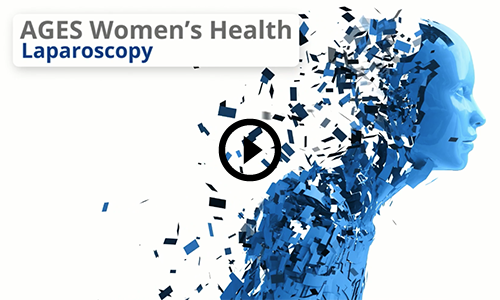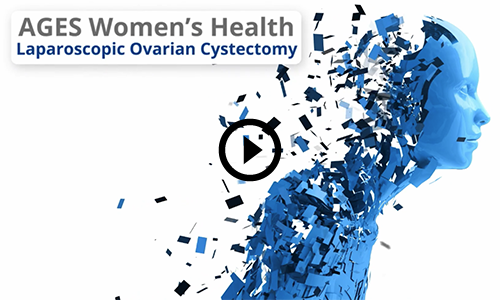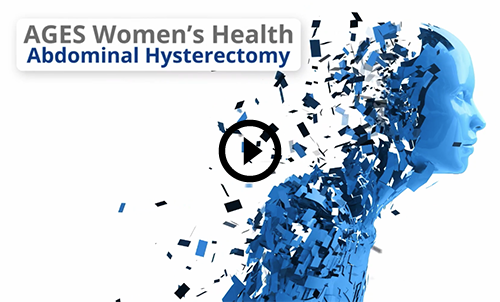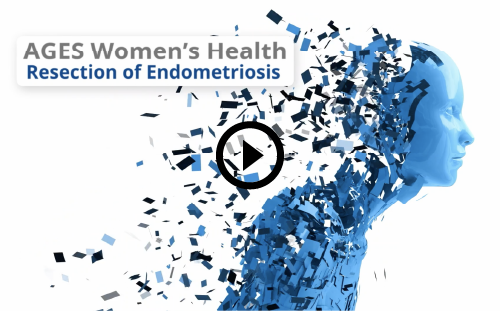Hysteroscopy is the inspection of the uterine cavity by endoscopy with access through the cervix. It allows for the diagnosis of intrauterine pathology and serves as a method for surgical intervention. A thin telescope called a hysteroscope is inserted into the uterus. This allows the doctor to inspect the uterine cavity and the fallopian tube openings.
Why am I having a Hysteroscopy?
A Hysteroscopy with endometrial sampling is the technique used to investigate any unusual bleeding.
What does a Hysteroscopy involve?
Hysteroscopy allows the doctor to look directly into the uterus. A thin telescope called a hysteroscope is inserted into the uterus. This allows the doctor to inspect the uterine cavity and the fallopian tube openings.
What is a D&C?
- The D&C (dilation and curettage) describes the process where the cervix, (entrance to the uterus) is stretched or dilated. This allows the passage of instruments used for looking inside the uterus and removing a sample of the lining.
- Curettage is the name of the procedure where some of the uterine lining is scraped off and checked in the laboratory to check it is healthy. Often we only sample the endometrium which is less invasive.
- Polyps and small fibroids may also be removed from inside the uterus during this procedure. The tissue that is removed is also sent to the laboratory for examination. The procedure can be done without any anaesthetic, sometimes sedation, local anaesthetic or general anaesthetic is used if indicated.
- It is important to arrange for someone to drive you home after your procedure.
How is a Laparoscopy performed?
- A general anaesthetic is required for laparoscopic procedures. A cut about one centimetre long is made below the belly button.
- A fine tube is passed through this cut and the abdomen is inflated with carbon dioxide gas. This creates space so that the pelvic organs can be seen clearly.
- The laparoscope (narrow telescope with a light) is inserted, allowing the gynaecologist to see the pelvis and pelvic organs. Other small cuts are made which allow different laparoscopic instruments to be introduced to perform the laparoscopic surgery.
What after effects should I expect?
- Nausea, discomfort, and tiredness are not uncommon for the first three days after laparoscopic surgery.
- Pain may be experienced where the cuts were made.
- There may be aching of the muscles, shoulder tip and rib cage pain because of the small amount of gas remaining under the diaphragm.
- Regular pain relief will help relieve the discomfort.
What are the risks?
- A full general anaesthetic is required so there are the usual risks relating to having an anaesthetic. The anaesthetist will discuss these with you.
- A diagnostic laparoscopy is considered to be a low risk procedure with fewer complications than for a laparoscopy carried out for treatment purposes. Laparoscopy has the risk of puncturing other abdominal structures such as the bowel, bladder and blood vessels, but the risks of this are very low.
- Sometimes the laparoscopy may be technically difficult and the surgeon may not be able to view the pelvis adequately. Under these circumstances an open surgical procedure may need to be done. This will be discussed when you consent to the procedure.
- The risk of complications increases with more complex laparoscopic surgery. These risks include damage to bowel, bladder, blood vessels (bleeding & hematoma), infection and sometimes having to proceed to open surgery. Risks are greater for women who are overweight, who have had previous abdominal surgery and who have other medical problems.
“Single Incision Laparoscopic Surgery” [SILS]
An advanced minimal access surgical procedure through a single incision.
Advantages - ease of tissue removal, less post op pin, better cosmesis, reduced port site complications (infection/hernia), decreased morbidity related to visceral and vascular injury and specimen removal through existing incision.
Challenges - limitation of working space with lack of triangulation compared with multi-port laparoscopy, significant learning curve and the surgeon needs to have good advanced laparoscopic skills.
![Single Incision Laparoscopic Surgery [SILS]](/assets/Uploads/sils.jpg)
Type of SILS procedures that Dr.Chowdary can offer:
- Tubal Ligation
- Ovarian cystectomy
- Bilateral Salpingo-oophorectomy
- Removal of ectopic pregnancies
- Myomectomy
- Total and Supracervical hysterectomy
- Excision of Endometriosis
Treatment of early stage endometrial cancer
- Endometrial Cancer appears to be increasing in women under 40 years of age in New Zealand.
- What is Endometrial (Uterine) Cancer? Endometrial cancer is a type of cancer that begins in the uterus. The uterus is the hollow, pear-shaped pelvic organ in women where fetal development occurs. Endometrial cancer begins in the layer of cells that form the lining (endometrium) of the uterus. Endometrial cancer is sometimes called uterine cancer. Other types of cancer can form in the uterus, including uterine sarcoma, but they are much less common than endometrial cancer. Endometrial cancer is often detected at an early stage because it frequently produces abnormal vaginal bleeding, which prompts women to see their doctors. If endometrial cancer is discovered early, removing the uterus surgically often cures endometrial cancer.
- Endometrial cancer, is the most common gynaecological cancer in New Zealand with around 380 new cases per year.
Heavy menstrual bleeding / Irregular bleeding
- Abnormal or irregular vaginal bleeding is any bleeding from your vaginal area that is not part of a regular period. It can be caused by infection and hormonal changes, but can also be a symptom of more serious problems.
- Causes of abnormal vaginal bleeding. Bleeding that is not a normal period could be caused by:
- hormonal changes (such as starting menopause or polycystic ovary syndrome)
- contraception such as the pill, injection, implant or IUD (intrauterine device)
- infection in your vagina or uterus
- fibroids or polyps inside your uterus
- trauma to your vagina
- some medications such as anticoagulants
- underlying health problems such as bleeding or thyroid disorders
- cancer in the lining of your uterus, your cervix or vagina (this is rare).
Polycystic ovarian syndrome
Polycystic ovary syndrome (PCOS) is a condition related to elevated levels of certain hormones, causing the development of cysts in the ovaries. The condition can have a range of impacts on a woman's health and fertility.
Also known as polycystic ovarian syndrome, it is thought that PCOS affects up to 10% of all pre- menopausal women. Symptoms can first appear in childhood or adolescence and continue for the entirety of a woman's life. While PCOS cannot be cured, its effects on the body can be controlled. When left untreated, there is an increased risk of many other conditions, including high cholesterol levels, type 2 diabetes, gestational diabetes, cardiovascular disease, sleep apnoea, depression, and endometrial cancer.
Signs and symptoms
Symptoms of PCOS vary in nature and severity and may include:
- Irregular periods
- Excess hair growth (hirsutism) on the face and body
- Acne and oily skin
- Infertility
- Thinning or hair loss on the top of the head
- Weight gain or obesity.
Causes
Each month in a healthy ovary, an immature egg begins to develop and is released from the ovary when mature. In PCOS, an imbalance of certain hormones disrupts this ovulation process. As a result, an egg begins to develop but does not fully mature and therefore is not released. Instead, the follicle in which the immature egg is contained becomes a fluid-filled cyst. Each cyst is usually between two to six millimetres in diameter and, over time, multiple cysts can cover the ovary. As a result, polycystic ovaries can become enlarged. The cause of PCOS is not fully understood. The condition tends to run in families and a gene influencing the development of the condition has been identified. It is thought that the following factors also influence its development:
- Higher than normal levels of male hormones (testosterone) being made in the ovaries.
- A problem with insulin metabolism known as insulin resistance, which causes the body to produce more insulin. Excess insulin may cause the ovaries to produce too much testosterone, which can prevent normal ovulation.
Diagnosis
There is no test to definitively diagnose PCOS. Diagnosis involves taking a full medical history and assessing symptoms. Tests used to help diagnose the condition may include:
- A pelvic examination to determine if the ovaries are enlarged.
- Blood tests to measure hormone, glucose, and cholesterol levels.
- An ultrasound scan of the ovaries.
Ovarian cyst
- An ovarian cyst is a fluid filled space in the ovary. They are very common in pre-menopausal women, especially younger women. Most of them are benign (Non-malignant - non cancerous).
- There are broadly speaking 2 types of cysts, physiological or functional cysts, and pathological cysts. Physiological or Functional Cysts.
- The physiological cysts arise from the normal functions of the ovary through the menstrual cycle. In the first 2 weeks of the menstrual cycle an egg develops in a small follicular cyst in the ovaries. By the time of ovulation the cyst has grown to 2 -3 cm. Ovulation occurs (egg is released) and the cyst now becomes a corpus luteum. Its function is to make hormones to nurture a pregnancy or prepare the uterus for menstruation.
- Functional cysts form either in the follicular phase or the luteal phase of the process as outlined above. These cysts are larger, from 5cms, and they continue to make hormones, so menstruation can be delayed. These cysts are diagnosed by ultrasound scan (USS), showing as perfectly round, fluid filled sacs, and only require removal if they are causing unmanageable pain, or are not resolving. They tend to cause an achy feeling which may last for a few weeks, but usually they will resolve spontaneously. A further USS can be indicated in 2-3 months to see if the cyst has resolved. Women with larger cysts should be aware that increase in pain can indicate torsion (twisting of cyst) or rupture (bursting) so may need further assessment.
- Removal of Cysts: In some cases the cyst may need to be removed. This would involve a laparoscopy through tiny abdominal incisions to remove the cyst, and you would need to stay in hospital for 1 night. Women need to be aware that if there was any indication of malignancy (a cancerous cyst) or complications during the procedure that a mini laparotomy may be required (Small cut to bikini line area).
- Pathological Cysts: Pathological cysts have abnormal features, and are more likely to be solid in appearance. Many of these are benign tumours (non-cancerous), but need to be assessed and removed as they have the possibility of being, or becoming malignant. (cancerous). Assessment would involve USS and blood tests for tumour markers, and consultation with a Gynaecologist. Some of the types of cysts would include teratoma (dermoid cysts), which are most common in younger women, serous cystadenoma which has thin, serous fluid, mucinous cystadenoma, which are large cysts with thick fluid. These types of cysts will keep growing until they are removed.
- Removal of Cysts: For post- menopausal women a more extensive operation is likely to be recommended as the risk of malignancy is increased in this age group.
- Other pathological cysts are endometriomas (chocolate cysts), which are lumps of endometriosis that grow in the ovaries, and have dark brown fluid inside them. They would be removed as part of laparoscopy for endometriosis.
What is a colposcopy
During a colposcopy a specialist uses a microscope to check the cells in your cervix.
Colposcopy is safe and effective.
It is important to attend your colposcopy appointment even if you don’t have any symptoms.
What causes abnormal cells
Human papillomavirus (HPV) is the main cause of abnormal cell changes and cervical cancer. You can find more information about HPV at the end of this pamphlet and also in the pamphlet Cervical Screening: Understanding Cervical Screening Results, code HE4598 on www.healthed.govt.nz.
Early treatment of abnormal cervical cells has about a 95 percent success rate in stopping these cells developing into cervical cancer.
Before your appointment
Your appointment may take up to an hour, however the actual colposcopy only takes about 15 minutes.
You are welcome to bring someone to support you such as your partner, a family or whānau member or a friend.
During your colposcopy
You will be asked to lie on a bed with your legs placed in leg rests. A microscope will be put near your vagina. It will not touch your body. Just like when you had a cervical screening test, the specialist will put a speculum into your vagina. This makes it possible to see your cervix through the microscope.
Dr Chowdary will put liquid onto your cervix, to show up any abnormal cells. For some women this may sting a little. Some small tissue samples may be taken of cells that look abnormal. This is called taking a biopsy. When the tissue sample (a biopsy) is taken, you may feel a quick, sharp pinch.
After your colposcopy
At the clinic, Dr Chowdary will talk to you about what they saw during your colposcopy.
For a few days after your colposcopy you may have some pain, similar to period pain. Rest and do what you usually do when you have period pain.
If you had a biopsy, you may also bleed a little or have some reddish discharge from your vagina. This is normal and should stop within a week.
Until the bleeding stops and your cervix is healed, please:
- use sanitary pads, not tampons
- have showers instead of baths
- do not use spa pools and swimming pools
- do not have sex.
If you start to bleed more than when you have your period, or if the bleeding goes on for more than a week, please phone the clinic for advice.
Getting your results
Your biopsy sample is sent to a laboratory to find out exactly what sort of changes are happening in your cervix. It takes up to four weeks for the clinic to get your biopsy results. The clinic may post your results to you or phone you. If you have not received a letter or phone call after four weeks, please phone the clinic.
Your results will also be sent to the National Cervical Screening Programme as well as your health provider.
Endometriosis is a common inflammatory condition where tissue similar to the lining of the uterus (endometrium) is found outside the uterus.
The tissue can form lesions, nodules and cysts which are mostly found in the pelvis, the Pouch of Douglas, ovaries, bowel, ligaments and bladder. It can be common for adhesions (fibrous scar tissue which causes internal organs or tissue to stick together) to form. Cysts on an ovary (endometriomas) may also develop in more advanced stages of the disease.
Common symptoms include pelvic pain, unusual menstrual bleeding, and difficulty getting pregnant. In New Zealand, it is estimated the condition affects 120,000 or one in ten girls and women.
Endometriosis can usually be effectively managed through medication and/or surgery and lifestyle modifications.
Sign and symptoms
Painful periods (dysmenorrhoea) that cause distress can be the first sign that a young girl or woman has endometriosis. The most common symptoms of endometriosis include:
- Pelvic pain - usually, but not always, associated with menstrual periods. The pain can be severe and debilitating
- Bowel related symptoms such as bloating and fluctuating bowel habit, similar to irritable bowel syndrome (IBS)
- Pain during or after sexual intercourse
- Abnormal menstrual bleeding (heavy periods or bleeding between periods)
- Pain with ovulation
- Sub-fertility or infertility.
Other symptoms experienced may include:
- Lower back pain
- Constant tiredness / fatigue
- Premenstrual syndrome (PMS)
- Pain before or while passing urine or recurrent urinary tract infections.
Symptoms of endometriosis usually improve during pregnancy and after menopause.
The severity of symptoms experienced is not generally related to the extent of the disease, eg: some women with mild endometriosis can suffer severe symptoms, and vice versa. Not every woman with endometriosis will have regular monthly symptoms.
Chronic Pelvic Pain (CPP) affects one in every six woman and refers to ongoing pain in the lower abdomen or pelvis. It is experienced most often by women of childbearing age.
Women often underestimate their pain and when asked, only consider their few days of really bad pain each month. But if you experience some form of pain in your pelvis on most days of the month, then you may be suffering from CPP.
Chronic Pelvic Pain is not related to pregnancy or caused solely by menstruation or sexual intercourse. It can be caused by a range of conditions, including but not limited to:
- endometriosis
- pelvic inflammatory disease
- irritable bowel syndrome
- coeliac disease
Causes can be difficult to diagnose or sometimes there is no cause to be found. However, there are a range of treatments available that can treat or control pain. These include targeted medication; lifestyle changes; counselling; physiotherapy and surgery.



